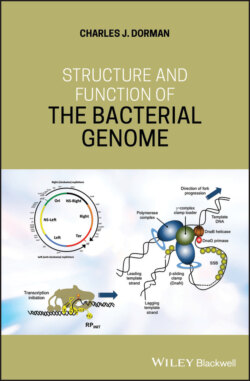Читать книгу Structure and Function of the Bacterial Genome - Charles J. Dorman - Страница 65
1.54 Small, Acid‐soluble Spore Proteins, SASPs
ОглавлениеAerobic and anaerobic spore‐forming bacteria rely on small, acid‐soluble spore proteins (SASPs) to protect their DNA from damage during the long (or very long) periods that may elapse between sporulation and spore germination. Most research on SASPs has been concerned with those produced by Bacillus spp. and Clostridium spp., aerobic and anaerobic organisms, respectively (Setkow 2007). The SASPs fall into two broad groups, the α/β type and the γ type. Their genes are transcribed with the G sigma factor (Nicholson et al. 1989), protect the genomic DNA in the spore, and after germination they are cannibalised as a source of amino acids by the emerging bacterial cell (Hackett and Setlow 1988; Setlow 1988). SASPs are specialists in that they are expressed specifically to accompany the genome during its period of storage in the spore and are degraded during germination; they do not have physiological roles in vegetative cells, yet they exhibit properties that are shared with NAPs. For example, they stiffen DNA, and eliminate DNA bends, they increase the persistence length of DNA and introduce supertwists into relaxed or nicked circular DNA (Griffith et al. 1994; Nicholson et al. 1990), including plasmids from spores (Nicholson and Setlow 1990). When cloned ssp genes expressing SASPs are introduced to E. coli, they induce nucleoid condensation; however, they also induce mutagenesis and cell killing (Setlow et al. 1991, 1992). The mutations accompanied expression of the B. subtilis SspC SASP and required RecA and Pol V, suggesting that the effects followed the arrest of replication forks in growing E. coli; a derivative of SspC that was deficient in DNA binding failed to elicit these deleterious effects when expressed in E. coli (Setlow et al. 1992). Overall, the effect of SASP expression in E. coli was to cause the Gram‐negative bacterium to assume some of the characteristics of a sporulating organism (Setlow et al. 1991).
